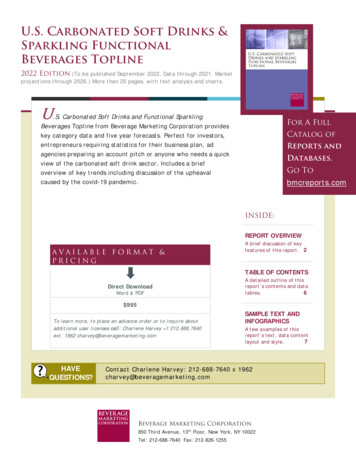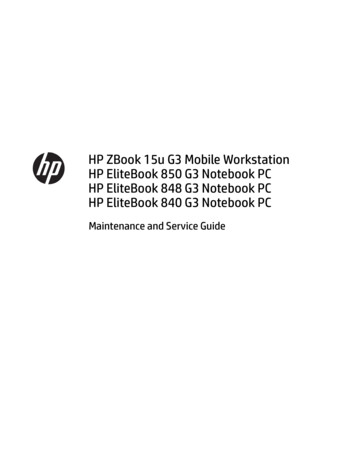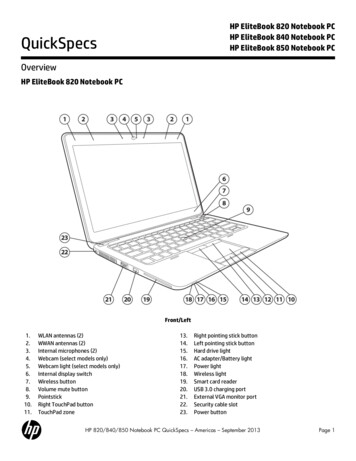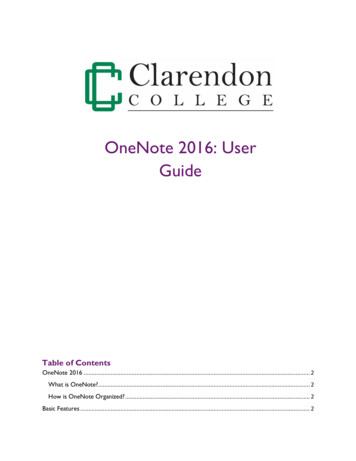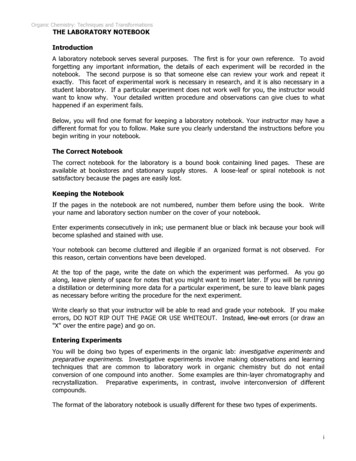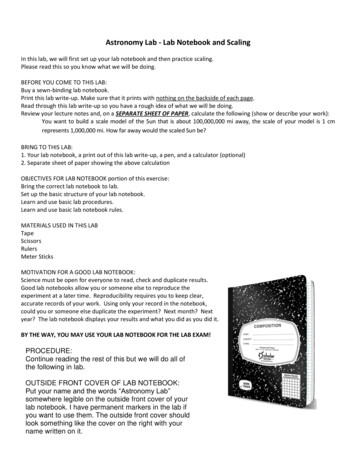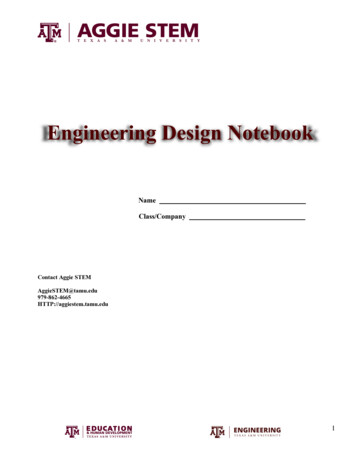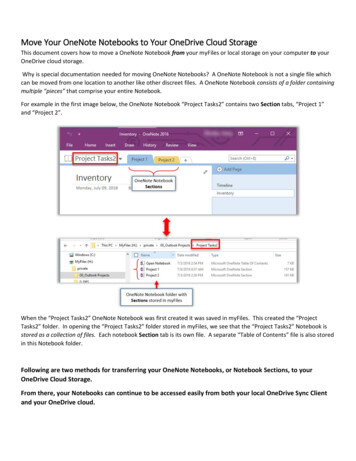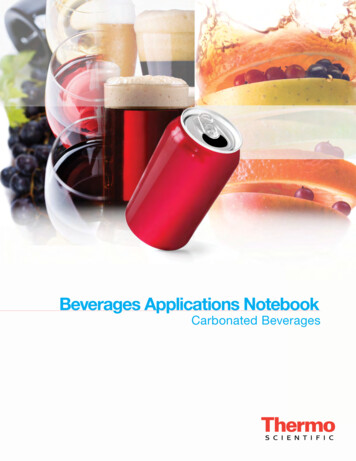
Transcription
Beverages Applications NotebookCarbonated Beverages
Table of ContentsIndex of Analytes. 3Introduction to Beverages. 4UltiMate 3000 UHPLC Systems. 5IC and RFIC Systems. 6MS Instruments. 7Chromeleon 7 Chromatography Data System Software. 8Process Analytical Systems and Software. 9Automated Sample Preparation. 10–11Analysis of Carbonated Beverages. 12Determination of Inorganic Ions and Organic Acids in Non-Alcoholic Carbonated Beverages. 13Rapid Determination of Phosphate and Citrate in Carbonated Soft Drinks Using a Reagent-FreeIon Chromatography System. 19Determination of Additives in Carbonated Beverages. 27Determination of Sucralose in Reduced-Carbohydrate Colas using High-Performance Anion-ExchangeChromatography with Pulsed Amperometric Detection . 34Fast Determinations of Phosphate and Citrate in Carbonated Beverages Using On-Line Degassingwith the Carbonate Removal Device (CRD) and a Reagent-Free Ion Chromatography System. 41Column Selection Guide. 48Column Selection Guide and Specifications. 49
Index of AnalytesAcesulfame. 27, 34Inorganic Ions. 13Aspartame. 27, 34Organic Acids. 13Caffeine. 27, 34Saccharin. 27Benzoate. 27, 34Sorbate. 27Citrate.19, 27, 41Sucralose. 343Index of Analytes
Introduction to BeveragesThe global beverage industry is growing each yearwith the introduction of new products, such as vitaminfortified water, energy drinks, anti-aging water, andherbal nutritional supplements. With this growth, comemany more analytical challenges. These challenges arecompounded by the continuing and new needs to analyzeclassic favorites such as sodas, fruit juices, milk drinks,alcoholic beverages, and bottled water. One such examplewould be the melamine contamination in milk and infantmilk formula.For all beverages, the compositional quality andsafety must be monitored to help track contamination,adulteration, product consistency, and to ensure regulatorycompliance from raw ingredients (water, additives, andfruits) to the final product.Thermo Fisher Scientific is a recognized leader inproviding analytical solutions for sample preparation,liquid chromatography for compositional testing, andchromatography data management for complianceand quality testing of beverages. From inorganic ions,organic acids, biogenic amines, glycols and alcohols,4carbohydrates and sugar alcohols, to vitamins, additives,and sugar substitutes, we are unique in our commitment toprovide fast, accurate testing and labeling information forall applications in this industry.Thermo Scientific and Dionex Integrated SystemsDionex Products are now a part of the ThermoScientific brand, creating exciting new possibilities forscientific analysis. Now, leading capabilities in liquidchromatography (LC), ion chromatography (IC), andsample preparation are together in one portfolio withthose in mass spectrometry (MS). Combining Dionex’sleadership in chromatography with Thermo Scientific’sleadership position in mass spec, a new range of powerfuland simplified workflow solutions now becomes possible.For more information on how the new lineup ofThermo Scientific products can expand your capabilitiesand provide the tools for new possibilities, choose one ofour integrated solutions: Ion Chromatography and Mass SpectrometryLiquid Chromatography and Mass SpectrometrySample Preparation and Mass SpectrometryIntroduction
UltiMate 3000 UHPLC SystemsBest-in-class HPLC systems for all yourchromatography needsThermo Scientific Dionex UltiMate 3000 UHPLC Systems provide excellent chromatographic performancewhile maintaining easy, reliable operation. The basicand standard analytical systems offer ultra HPLC(UHPLC) compatibility across all modules, ensuringmaximum performance for all users and all laboratories.Covering flow rates from 20 nL/min to 10 mL/min withan industry-leading range of pumping, sampling, anddetection modules, UltiMate 3000 UHPLC Systemsprovide solutions from nano to semipreparative, fromconventional LC to UHPLC. 5Superior chromatographic performanceUHPLC design philosophy throughout nano,standard analytical, and rapid separation liquidchromotography (RSLC)620 bar (9,000 psi) and 100 Hz data rate set a newbenchmark for basic and standard analytical systemsRSLC systems go up to 1000 bar and data rates up to200 Hz 2 Dual System for increased productivity solutionsin routine analysisFully UHPLC compatible advancedchromatographic techniques Thermo Scientific Dionex Viper and nanoViper–thefirst truly universal, fingertight fitting system even atUHPLC pressuresThermo Fisher Scientific is the only HPLC companyuniquely focused on making UHPLC technology availableto all users, all laboratories, and for all analytes.Rapid Separation LC Systems: The extended flowpressure footprint of the RSLC system provides theperformance for ultrafast high-resolution and conventionalLC applications.RSLCnano Systems: The Rapid Separation nanoLC System (RSLCnano) provides the power for highresolution and fast chromatography in nano, capillary, andmicro LC.Standard LC Systems: Choose from a wide variety ofstandard LC systems for demanding LC applications atnano, capillary, micro, analytical, and semipreparativeflow rates.Basic LC Systems: UltiMate 3000 Basic LC Systemsare UHPLC compatible and provide reliable, highperformance solutions to fit your bench space andyour budget.Liquid Chromatography Systems
IC and RFIC SystemsA complete range of ion chromatography solutions forall customer performance and price requirementsFor ion analysis, nothing compares to a ThermoFisher Scientific ion chromatography system. Whetheryou have just a few samples or a heavy workload, whetheryour analytical task is simple or challenging, we have asolution to match your needs and budget. And with yourIC purchase, you get more than just an instrument—youget a complete solution based on modern technology andworld-class support. Thermo Scientific Dionex ICS-5000: The world’sfirst capillary IC systemDionex ICS-2100: Award-winning integratedReagent-Free IC systemDionex ICS-1600: Standard integrated IC systemDionex ICS-1100: Basic integrated IC systemDionex ICS-900: Starter line IC systemRanging from the Dionex ICS-900 to the ICS-5000,these IC systems cover the entire range of IC needsand budgets and come with superior support andservice worldwide.6Dionex ICS-5000: Developed with flexibility, modularity,and ease-of-use in mind, the Dionex ICS-5000 combinesthe highest sensitivity with convenienceDionex ICS-2100: An integrated Reagent-Free IC(RFIC ) system for electrolytically generated isocraticand gradient separations with conductivity detection, nowwith electrolytic sample preparation.Dionex ICS-1600: The Dionex ICS-1600 combineshigh sensitivity with convenience. Now ready for eluentregeneration, with available dual-valve configuration forautomated sample preparation.Dionex ICS-1100: With dual-piston pumping andelectrolytic suppression. Now ready for eluentregeneration, with available dual-valve configuration forautomated sample preparation.Dionex ICS-900: Can routinely analyze multiple anionsand cations in 10–15 min—fully automated withDisplacement Chemical Regeneration (DCR).Ion Chromatography Systems
MS InstrumentsSingle-point control and automation for improved easeof-use in LC/MS and IC/MSThermo Fisher Scientific provides advancedintegrated IC/MS and LC/MS solutions with superiorease-of-use and modest price and space requirements.UltiMate 3000 System Wellness technology andautomatic MS calibration allow continuous operation withminimal maintenance. The Dionex ICS-5000 instrumentand the family of RFIC systems automatically removemobile phase ions for effort-free transition toMS detection. 7Thermo Scientific MSQ Plus mass spectrometer, thesmallest and most sensitive single quadrupole on themarket for LC and ICSelf-cleaning ion source for lowmaintenance operation Thermo Scientific Dionex ChromeleonChromatography Data System software forsingle-point method setup, instrument control, anddata managementCompatible with existing IC and LC methodsThe complete system includes the MSQ Plus massspectrometer, PC datasystem, electrospray ionization(ESI) and atmospheric pressure chemical ionization(APCI) probe inlets, and vaccum systemYou no longer need two software packages to operateyour LC/MS system. Chromeleon LC/MS softwareprovides single-software method setup and instrumentcontrol; powerful UV, conductivity, and MS data analysis;and fully integrated reporting.MS Systems and Modules: MSQ Plus Mass Spectrometer;MSQ18LA nitrogen gas generator; Thermo ScientificDionex AXP-MS digital auxiliary pumpMS Instruments
Chromeleon 7 Chromatography DataSystem SoftwareThe fastest way to get from samples to results Discover Chromeleon software version 7, thechromatography software that streamlines your pathfrom samples to results. Get rich, intelligent functionalityand outstanding usability at the same time withChromeleon software version 7—the Simply Intelligent chromatography software. 8Enjoy a modern, intuitive user interface designedaround the principle of operational simplicityStreamline laboratory processes and eliminate errorswith eWorkflows, which enable anyone to perform acomplete analysis perfectly with just a few clicksAccess your instruments, data, and eWorkflowsinstantly in the Chromeleon ConsoleLocate and collate results quickly and easily usingpowerful built-in database query featuresInterpret multiple chromatograms at a glance usingMiniPlotsFind everything you need to view, analyze, and reportdata in the Chromatography StudioAccelerate analyses and learn more from your datathrough dynamic, interactive displaysDeliver customized reports using the built-in Excelcompatible speadsheetChromeleon software version 7 is a forward-lookingsolution to your long-term chromatography data needs.It is developed using the most modern software tools andtechnologies, and innovative features will continue to beadded for many years to come.The Cobra integration wizard uses an advancedmathematical algorithm to define peaks. This ensures thatnoise and shifting baselines are no longer a challengein difficult chromatograms. When peaks are not fullyresolved, the SmartPeaks integration assistant visuallydisplays integration options. Once a treatment is selected,the appropriate parameters are automatically included inthe processing method.Chromeleon software version 7 ensures dataintegrity and reliability with a suite of compliance tools.Compliance tools provide sophisticated user management,protected database stuctures, and a detailed interactiveaudit trail and versioning system.Chromatography Data Systems
Process Analytical Systems and SoftwareImprove your process by improving your processmonitoring with a Thermo Scientific Dionex on-line ICor HPLC system Our process analytical systems provide timely resultsby moving liquid chromatography-based measurementson-line. Information from the Thermo Scientific DionexIntegral process analyzer can help reduce processvariability, improve efficiency, and reduce downtime.These systems provide comprehensive, precise, accurateinformation faster than is possible with laboratory-basedresults. From the lab to the factory floor, your plant’sperformance will benefit from the information providedby on-line LC. 9Characterize your samples completely withmulticomponent analysisReduce sample collection time and resources withautomated multipoint samplingImprove your process control with moretimely resultsSee more analytes with unique detection capabilities25 years of experience providing on-line IC andHPLC capabilities to a wide range of industriesThe Thermo Scientific Integral Migration Pathapproach lets you choose the systems that best meetsyour needsThe Integral Migration Path approach enableson-line IC/HPLC to generate timely, high-resolutioninformation when monitoring a small-scale reactorin a process R&D lab, in a pilot plant, or improvingcurrent manufacturing plant processes. No matter whatthe application, the Integral process analyzer has theversatility to place a solution using on-line IC/HPLC,whenever and wherever it is needed.Integral: The Integral Migration Path approach:System solutions wherever you need them: lab, pilotplant, or manufacturingChromeleon Process Analytical (PA) Software:Chromeleon PA software provides unique capabilities tosupport on-line IC or HPLC analysisProcess Analytical Systems and Software
Automated Sample PreparationAccelerated Solvent ExtractorsTwo new solvent extraction systems with pH-hardenedDionium componentsWe offer two solvent extraction systems. The ThermoScientific Dionex ASE 150 Accelerated Solvent Extractoris an entry-level system with a single extraction cell, for10laboratories with modest throughput. The DionexASE 350 system is a sequential extraction systemcapable of automated extraction of up to 24 samples.Both systems feature chemically inert Dioniumcomponents that allow the extraction of acid- or basepretreated samples.Automated Sample Preparation
Solid-Phase Extraction SystemsFaster, more reliable solid-phase extraction while usingless solventThe Thermo Scientific Dionex AutoTrace 280 SolidPhase Extraction (SPE) instrument unit can process sixsamples simultaneously with minimal intervention. Theinstrument uses powerful pumps and positive pressurewith constant flow-rate technology. Current analyticalmethods that require SPE sample preparation includegas chromatography (GC), GC-MS, LC, and LC-MS, ICand IC-MS. The Dionex AutoTrace 280 instrument isapproved or adapted for U.S. EPA clean water methodsand safe drinking water methods (600 and 500 series) andcan extract the following analytes: 11PCBs (polychlorinated biphenyls)OPPs (organophosphorus pesticides),OCPs (organochlorine pesticides), andchlorinated herbicides BNAs (base, neutral, acid semivolatiles)Dioxins and furansPAHs (polyaromatic hydrocarbons)Oil and grease or hexane extractable materialWith SPE, large volumes of liquid sample are passedthrough the system and the compounds of interest aretrapped on SPE adsorbents (cartridge or disk format), theneluted with strong solvents to generate an extract ready foranalysis. Automated SPE saves time, solvent, and laborfor analytical laboratories.Dionex AutoTrace Systems: The new DionexAutoTrace 280 system provides fast and reliableautomated solid phase extraction for organic pollutantsfrom liquid samplesDionex AutoTrace Accessories: High-quality parts andaccessories are available for Dionex AutoTrace 280instrumentsAutomated Sample Preparation
Analysis of Carbonated Beverages
Application Note 25Determination of Inorganic Ions and OrganicAcids in Non-Alcoholic Carbonated BeveragesINTRODUCTIONThe determination of inorganic anions and cationsand organic acids in non-alcoholic carbonated beveragesis of importance from both health-related and manufacturing perspectives. Organic acids such as citrate and malate,and inorganic anions such as phosphate are monitored dueto their function as acidifiers or flavor enhancers. Chloride is monitored due to restrictions imposed by differentcountries and many Group I and II metals are monitoredfor purposes of mass balance. Thus, the content of thesecompounds needs to be monitored by the manufacturer tomaintain product quality and to investigate possible patentinfringements in competitive products.Ion chromatography (IC) is a well established technique for the determination of ions in solution. Thisapplication note describes the use of ion exchange orion exclusion chromatography (ICE) with suppressedconductivity detection for the determination of inorganicanions, cations, and organic acids in several popularcarbonated beverages.EQUIPMENTA Dionex chromatographic system consisting of:Gradient PumpChromatography ModuleConductivity DetectorEluent Organizer or Eluent Degas ModuleAutosamplerDionex PeakNet Chromatography Workstation13REAGENTS AND STANDARDSDeionized water (DI H2O), 17.8 MΩ-cm or betterAnion AnalysisSodium hydroxide solution, 50% w/w (Fisher Scientific)Methanol (EM Science)Cation AnalysisMethanesulfonic acid, 99% pure (Fluka Chemika-BioChemika)Organic Acid AnalysisPerchloric acid (Fluka Chemika-BioChemika)Tetrabutylammonium hydroxide (Dionex, P/N 39602)PREPARATION OF SOLUTIONS AND REAGENTS100 mM Sodium HydroxideWeigh 992 g (992 mL) of 17.8 MΩ deionized waterinto a 1-L eluent reservoir bottle. Vacuum degas thewater for approximately 10 minutes. Tare the bottle on thebalance and add 8.00 g (5.25 mL) of 50% sodium hydroxide directly to the bottle. Quickly transfer the eluent bottleto the instrument and pressurize it with helium.1 mM Sodium HydroxidePlace 990 g (990 mL) of 17.8 MΩ deionized waterinto a 1-L eluent reservoir bottle. Vacuum degas the water forapproximately 10 minutes. Add 10 mL of 100 mM sodiumhydroxide directly to the bottle. Quickly transfer the eluentbottle to the instrument and pressurize it with helium.Determination of Inorganic Ions and Organic Acids in Non-Alcoholic Carbonated Beverages
100 mM Methanesulfonic AcidWeigh out 9.61 g of methanesulfonic acid (MSA).Carefully add this amount to a 1-L volumetric flask containing about 500 mL of deionized water. Dilute to themark and mix thoroughly.0.8 mM Perfluorobutyric AcidPerfluorobutyric acid (heptafluorobutyric acid) issupplied by Fluka in 10.0-mL bottles. Dilute the entirecontents of one 10.0-mL bottle in 1 L to obtain a0.0772 M stock solution. Dilute 10.4 g of the stock solution in 1 L to obtain the 0.8 mM working eluent.5 mM Tetrabutylammonium HydroxideDilute 200 mL of the Dionex 0.1 M tetrabutylammonium hydroxide regenerant solution (P/N 39602)to 4 L with water. Alternatively, dilute 10 mL of 55%tetrabutylammonium hydroxide in 4 L of water.RESULTS AND DISCUSSIONInorganic AnionsInorganic anions such as chloride, nitrate, and sulfatepresent in carbonated beverages are usually derived fromthe water used in production. Some anions, however,such as phosphate may be added deliberately to impart aparticular flavor or acidity. The water can be monitoredby ion chromatography to ensure purity and consistency,while the final product is monitored to maintain productquality.Inorganic anions are separated by anion-exchangechromatography, and monitored by suppressed conductivity detection; Table 1 lists the experimental conditions.When performing gradient elution on the AS11 column,a hydroxide eluent system is used instead of a carbonateeluent, because of its lower background conductivity. AnAnion Trap Column (ATC) should be installed betweenthe gradient pump and the injection valve to minimizebaseline shifts resulting from the elution of anionic contaminants in the eluent.Figures 1–4 show the separations of inorganic andorganic anions in a variety of carbonated beverages usingthe AS11 column. The samples were degassed and diluted1:10 prior to injection. The sodium hydroxide concentration in eluent 1 is weak enough that not only is fluorideeluted after the void, but several weakly retained monovalent organic acids are also resolved. Thus, using theconditions described in Table 1, it is possible to separate14not only the strong acid anions, but also a variety of weakorganic acids. To obtain a flat baseline for these chromatograms, the baseline subtraction option in the PeakNetsoftware was used.Figures 1, 2, and 4 show that phosphate or citratewas used to acidify the beverages. Figure 3, which showsthe separation of anions in a flavored carbonated water,naturally has no phosphate or citrate. All four beveragescontain chloride and sulfate, with all but the water alsocontaining some nitrate. A small amount of fluoride,Table 1 Experimental Conditions for the Separationof Inorganic Anions in Carbonated BeveragesUsing the IonPac AS11 ColumnColumn:Eluent 1:Eluent 2:Eluent 3:Eluent 4:Gradient:IonPac AS11 Analytical (4 mm)IonPac AG11 Guard (4 mm)ATC-1 Anion trapDeionized water1 mM Sodium hydroxide100 mM Sodium 2018.0042—2 mL/min25 µLSuppressed conductivity, ASRS,external water modeFlow Rate:Inj. Volume:Detection:Peaks: 1.2.3.4.5.6.14E3———38E4——1420Chloride1.9 mg/LNitrate4.2Unidentified —Sulfate2.7Phosphate 36.0Citrate4.25µS1243600510Minutes152011440Figure 1. Separation of inorganic anions and organic acids in acola by anion exchange chromatography. Conditions as listed inTable 1.Determination of Inorganic Ions and Organic Acids in Non-Alcoholic Carbonated Beverages
420µSPeaks: 1.2.3.4.5.ChlorideNitrateMalateSulfateCitrate8.1 mg/L1.21.82513051Peaks: 1. Chloride2. Succinate3. Sulfate15042 mg/L2.511µS3200510Minutes3201520011441Figure 2. Separation of inorganic anions and organic acids in acarbonated lemon drink by anion exchange chromatography. Conditions as listed in Table 1.which is sometimes added to municipal water suppliesto prevent tooth decay, is also found in the synthetic grapeflavored beverage.Reproducibility for this method is on the order of0.5% or better for retention times and 2% or better forpeak areas. Linearity is good over the range tested(1.5 orders of magnitude), with a coefficient of determination, r2 0.999 for most of the analytes. These statisticswere determined prior to baseline subtraction.As is the case with the inorganic anions, many inorganic cations are introduced into carbonated beveragesfrom the water. Others are introduced as counterions toadded ingredients. The four major cations in carbonatedbeverages are sodium, potassium, calcium, and magnesium.Inorganic cations can be separated by ion exchangechromatography, and monitored by suppressed conductivity detection, as described in Table 2. The step gradient allows the separation of barium and strontium in addition tothe standard 5 cations, sodium, ammonium, potassium,magnesium, and calcium. A step change at 5 minutesfrom the weak eluent to a stronger one allows for the elution of sharp peaks for the divalent cations. If it is not necessary to monitor for barium or strontium, the conditionscan be changed to allow isocratic elution of the 5 cationsshown in Figure 7, in less than 10 minutes. For isocraticelution, the eluent is 20 mM methane-sulfonic acid.2015Peaks: 1.2.3.4.5.11442Unidentified —Chloride2.1 nutes152011443Figure 4. Separation of inorganic anions and organic acids in acarbonated synthetic grape drink by anion exchange chro-matography. Conditions as listed in Table 1.Table 2 Experimental Conditions for the Separationof Inorganic Cations in Carbonated BeveragesUsing the IonPac CS12 ColumnColumn:Eluent 1:Eluent 2:Gradient:Flow Rate:Inj. Volume:Detection:1510MinutesFigure 3. Separation of inorganic anions and organic acids in aflavored carbonated water by anion exchange chromatog raphy.Conditions as listed in Table 1.0Inorganic Cations5IonPac CS12 Analytical (4 mm)IonPac CG12 Guard (4 mm)CTC-1 Cation trapDeionized water100 mM Methanesulfonic 0 mL/min25 µLSuppressed conductivity, CSRS, recycle modeDetermination of Inorganic Ions and Organic Acids in Non-Alcoholic Carbonated Beverages
Peaks: 1. Sodium17 mg/L2. Magnesium 1.53. Calcium1030118Peaks: 1. Sodium11 mg/L2. Magnesium 0.33. Calcium2.313µSµS322000246Minutes81012Figure 5. Separation of inorganic cations in a carbonated lemondrink by cation exchange chromatography. Conditions as listed inTable 2.Figures 5–8 show the separation of cations in a seriesof carbonated beverages by cation exchange chromatography. The samples were degassed and diluted 1:10prior to injection. The two synthetic beverages shownin Figures 5 and 6 contain only sodium, magnesium, andcalcium, but the two carbonated juices shown in Figures 7and 8 also contain a considerable quantity of potassium.The reproducibility of this method is on the order of 0.5%or better for retention times and 2% or better for peak areas. Linearity was good over the range tested (2 orders ofmagnitude) with a coefficient of determination, r2 0.999or better for all but ammonium.Organic Acid AnalysisOrganic acids such as citrate or malate are oftenintroduced into carbonated beverages in definite proportions to impart a particular flavor. For carbonatedfruit juice beverages, some organic acids may be present naturally in the fruit. In addition, the presence ofsome organic acids can be used to reveal potential foodadulteration.One way to separate and detect organic acids is with ionexclusion chromatography using suppressed conductivity detection. The IonPac ICE-AS6 column is an ionexclusion column designed for efficient separation of lowmolecular weight aliphatic organic acids including hydroxy-substituted organic acids, as well as for aliphaticalcohols and glycols. Using this separation mechanism,weakly ionized acids are separated based on differencesin their pKas. Strong inorganic acid anions are not retained by the stationary phase and elute in the excludedvolume of the column. The standard eluent for use with1601144426Minutes48121011445Figure 6. Separation of inorganic cations in a carbonated, synthetic grape drink by cation exchange chromatography. Conditions as listed in Table 2.Peaks: 1.2.3.4.5.340Sodium6.9 mg/LAmmonium 0.9Potassium 96Magnesium 2.5Calcium2.6µS415200246Minutes81011446Figure 7. Separation of inorganic cations in a carbonated applejuice by cation exchange chromatography. Conditionsas listed in Table 2.20Peaks: 1.2.3.4.5.1Sodium17 mg/LAmmonium 1.5Potassium 21Magnesium 1.5Calcium2.63µS45200246Minutes8101211447Figure 8. Separation of inorganic cations in a carbonated grapejuice by cation exchange chromatography. Conditionsas listed in Table 2.Determination of Inorganic Ions and Organic Acids in Non-Alcoholic Carbonated Beverages
Table 3 Experimental Conditions for the Separationof Organic Acids in Carbonated Beveragesby Ion Exclusion Chromatography Usingthe IonPac ICE-AS6 ColumnColumn:Eluent:Flow Rate:Inj. Volume:Detection:Regenerant:IonPac ICE-AS6 Analytical0.8 mM Heptafluorobutyric acid1.0 mL/min25 µLSuppressed conductivity, AMMS-ICE5 mN Tetrabutylammonium hydroxide at 5 mL/minthe IonPac ICE-AS6 is 0.4 mM heptafluorobutyric acid(perfluorobutyric acid). Although other monoprotic acidscan be used as eluents, to do so will increase both thebackground conductivity and the noise. The experimentalconditions are listed in Table 3.Figures 9–12 show the separation of organic acidsin a group of carbonated beverages by ion exclusionchromatography. The samples were degassed and diluted1:10 (1:50 for the carbonated grape juice) prior to injection. Inorganic anions are eluted on either side of thewater dip and do not interfere with the separation of mostof the organic acids. The major exception is with oxalate,which is also eluted at the water dip. Figure 9 shows theorganic acid profile in a flavored carbonated water, whichcontains no organic acids as expected. Figures 10 and 11show the organic acid profiles in two synthetic carbon-atedbeverages with only citrate being readily apparent. Citrateis often added to carbonated beverages to impart a certainacidity, but is also present in citric fruit; thus, explainingthe higher concentration of citrate in t
approach lets you choose the systems that best meets your needs The Integral Migration Path approach enables on-line IC/HPLC to generate timely, high-resolution information when monitoring a small-scale reactor in a process R&D lab, in a pilot plant, or improving current manufacturing plant processes. No matter what

